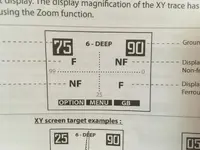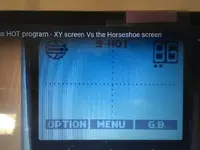The 3 bars do appear to correspond to the ground adjustment points, although what is being displayed is the actual ground phase reading. Go figure.
Andy Sabisch dedicates a few pages in his book on this screen. Ironically, XP in the user manual and Andy in his book label the axis differently. In Andy's book, the horzontal axis is labeled -99 to +99 and the vertical axis simply has a "0" at the top of the vertical axis and no number. Just know that the upper left side is ferrous and is mirrored on the lower right and the upper right side is non-ferrous and mirrored on the lower-left. Strong mixed ferrous will typically give an "unstable" graphic shape (even with a high TID) or a single line going from upper left to lower right, whereas, a pure, round non-ferrous target will give a nice straight line going from lower left to upper right with the length of the line corresponding to signal strength (roughly corresponding to depth and/or mass) and the slope corresponding to the target ID. Higher conductive non-ferrous target ID will have a shallow (more towards horzontal) slope and lower conductive non-ferrous target will have a steeper (more towards vertical) slope. Irregularly shaped non-ferrous like can slaw or bent pull tabs will result in circles or oval shapes in spanning the lower left to upper right quadrants. Andy states that the upper two quadrants are simply mirrored by the their corresponding lower diagonal quadrants. I think the axis labels in the books are basically meaningless. Focus on the shape, slope, and displayed target ID. I have found that once I have gotten used to the Deus audio I get basically the same info as the visual X-Y display so it rarely is of any use to me. Furthermore, it is practically useless in thick target areas where all the various targets tend to jumble up on screen because of the delays associated with display (while the audio has already "moved on" to the next target). The distorted shapes associated with most junk targets come across as distorted audio in the headphones even if the the target ID seems good. Interesting to play with, not very practical in many situations and redundant to the audio tone ID nuances once you have trained your ear IMO. HTH





